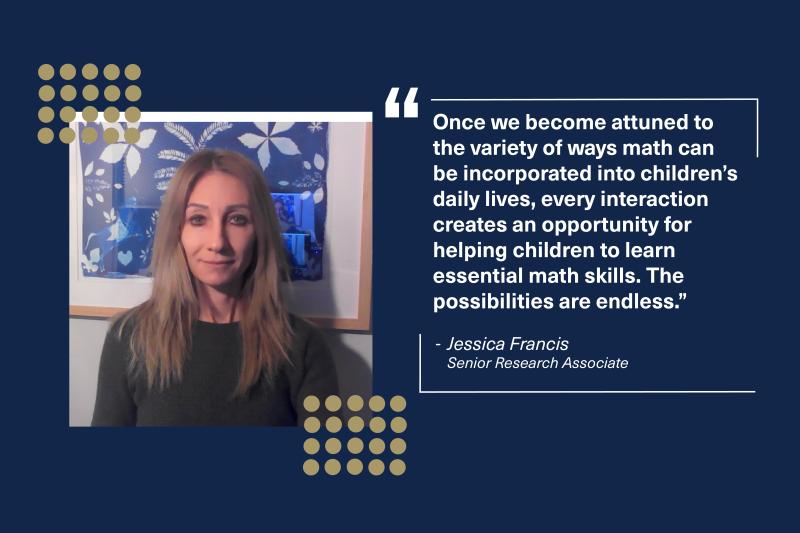Research shows that young children are capable of learning complex mathematics (Clements and Sarama, 2011); however, mathematics tends to receive minimal attention in early childhood classrooms (Farran et al., 2017; Bachman et al., 2018). This may be because preschool teachers have had very little training in teaching mathematics (Ginsburg et al., 2014), and they tend to feel unequipped to teach mathematics (Ginsburg et al., 2008). As a researcher who has observed hundreds of preschool classrooms throughout the U.S. for different research studies, I have learned to appreciate how early math can be learned through simple language and play. Early math concepts can include counting, one-to-one correspondence, number recognition, geometry, spatial relationships, mathematical terminology, measurement, estimation, classification, seriation and rudimentary addition and subtraction. Here are five examples from teachers I’ve observed who have organically fostered children’s math development in early childhood classrooms.
One-to-One Correspondence
Three children set up a “party” in the dramatic play center during free choice time. The teacher visits with the children and asks whether they have one place set at the table for each party invitation they have made. The children count their five party invitations and realize they only have four place settings. One child quickly creates an additional place setting and confirms that they now have one place setting corresponding to each party invitation.
Counting and Recognizing Numbers
During morning circle time, the teacher asks the children to count how many boys and girls are present. In the block area during free choice time, the teacher asks, “How many people are in the building you are making?” The children count them together. In the dramatic play area, the teacher asks one child to find a “size 6” shoe and another child to write down a pretend telephone number to call her friend.
Estimation and Classification
The teacher makes her way to different centers as children play. She asks one child in the table toy area to count to see if there are more marbles in the red or blue bowl. At the sand table, she asks another child how many scoops of sand it will take to fill the sand table. When he guesses nine big scoops, she asks him how many small scoops he thinks it will take. Later, the teacher points out the graph on the wall they created that shows how many children are wearing shoes versus boots and how many children have long hair versus short hair.
Geometry and Spatial Relationships
In the art area, the teacher helps a child paint half a side of paper, fold it in half, and discuss what happened to the shape. She points out the red and yellow flower pattern in another child’s drawing. Over in the table toys area, the teacher arranges materials in a progressive pattern – 1 blue cat, 2 red cats, 3 yellow cats, 1 blue cat – and asks a child what comes next. To encourage children to explore and understand spatial relationships, the teacher asks questions such as “What size blocks do you think you will need to fit in this space? I notice that you turned that puzzle piece around to fit it in the right place. How did you know that puzzle piece was going to fit there? How does the playground look different when you are standing up there?”
Measurement
Teachers point out measurements, such as “I see your building is taller than his building.” They also ask questions such as “Which cup do you think will hold more water? Whose line of marbles is longer? Which block would you use to fit across the top of the building?”
Butler’s Early Childhood Team and You
Early math is one of many components within early childhood settings that researchers at Butler Institute recognize as critical for supporting children’s development. Once we become attuned to the variety of ways math can be incorporated into children’s daily lives, every interaction creates an opportunity for helping children to learn essential math skills. The possibilities are endless.
Resources to Learn More
Bachman, H., Degol, J., Elliott, L., Scharphorn, L., Nokali, N., & Palmer, K. (2018). Preschool math exposure in private center-based care and low-SES children’s math development. Early Education and Development, 29(3), 417-434. doi: 10.1080/10409289.2017.1406245
Clements, D. & Sarama, J. (2011). Early childhood mathematics intervention. Science, 333(6045), 968–970. doi:10.1126/science.1204537
Farran, D. C., Meador D., Christopher C., Nesbitt, K., & Bilbrey, L. (2017). Data-driven improvement in prekindergarten classrooms: Report from a partnership in an urban district. Child Development, 88(5), 1466-1479. doi: 10.1111/cdev.12906
Ginsburg H, Hyson M, and Woods T (2014). Preparing early childhood educators to teach math: Professional development that works. Baltimore, MD: Brookes Publishing.
Ginsburg H, Lee J, and Boyd J (2008). Mathematics education for young children: What it is and how to promote it. Society for Research in Child Development Social Policy Report 22: 3-22.
